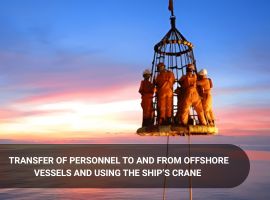
Aims:
The course aims to equip maritime and offshore personnel with the knowledge, skills, and best practices for safely transferring personnel between vessels, offshore platforms, and other marine structures. It focuses on minimizing risks, ensuring compliance with international safety standards, and enhancing operational efficiency during personnel transfers.
Objectives:
By the end of this course, participants will be able to:
- Understand the Fundamentals of Personnel Transfers – Identify the risks, challenges, and regulatory requirements for safe offshore personnel transfers.
- Recognise Roles and Responsibilities – Define the duties of the master, crane operator, banksman, and transferred personnel in ensuring safe transfers.
- Apply Best Practices for Safe Transfers – Implement proper procedures using personnel baskets, cranes, gangways, and other transfer methods.
- Assess Environmental and Operational Conditions – Evaluate weather, sea state, visibility, and vessel stability before initiating transfers.
- Ensure Compliance with Safety Equipment Requirements – Verify the use of life vests, PPE, lifebuoys, and other life-saving equipment.
- Understand Communication Protocols – Maintain clear and effective communication between vessels, cranes, and deck teams.
- Manage Emergency Situations – Develop response plans for incidents such as man-overboard situations or equipment failure.
- Handle Commercial Pressures Responsibly – Ensure safety remains the top priority despite operational or logistical demands.
Modules:
- Understand the Fundamentals of Personnel Transfers
- Recognize Roles and Responsibilities
- Apply Best Practices for Safe Transfers
- Assess Environmental and Operational Conditions
- Ensure Compliance with Safety Equipment Requirements
- Understand Communication Protocols
- Manage Emergency Situations
- Risk Assessment
- Teacher: AIMS MARITIME

